Autotrophic Nutrition
Autotrophic nutrition is defined as a type of nutrition in which organisms synthesize organic materials (food) from the inorganic source by the process of photosynthesis.
Photosynthesis
The overall equation for photosynthesis is:
6CO2 + 12H2O → C6H2O6 + H2O + O2
Carbohydrates are utilised for providing energy to the plant. The carbohydrates which are not used
immediately are stored in the form of starch, which serves as the internal energy reserve to be used as and when required by the plant.
Example: green plants and autotrophic bacteria. Events occurring during photosynthesis:
- Absorption of light energy by chlorophyll.
- Conversion of light energy to chemical energy and splitting of water molecules into hydrogen and oxygen.
- Reduction of carbon dioxide to carbohydrates.
These steps need not take place one after the other immediately.
For example, desert plants take up carbon dioxide at night and prepare an intermediate which is acted upon by the energy absorbed by the chlorophyll during the day.
Cross-section of a Leaf:
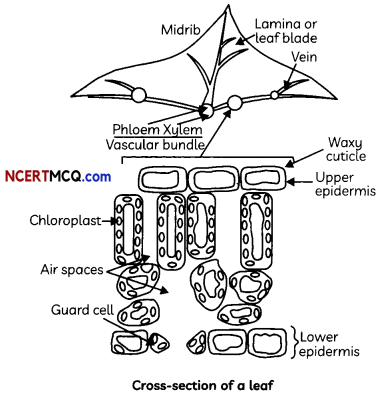
Some cells contain green dots which are cell organelles called chloroplasts which contain chlorophyll.
![]()
The function of Chlorophyll:
Chlorophyll is a pigment present in cell organelles called plastid, which lies just below the upper epidermis in a tissue called palisade. It is a photoreceptor molecule. There are different types of chlorophyll molecules like chlorophyll a, b, c, d, e and bacteriochlorophyll. Chlorophylls absorb mostly the blue and red regions of spectrum.
Exchange of Gases in Plants
Gaseous exchange takes place in the leaves through stomata which are tiny pores present on the surface of the leaves. The exchange of gases occurs across the surface of stems, roots and leaves as well.
The plant closes these pores when it does not need carbon dioxide for photosynthesis since large amounts of water can also be lost through these stomata.
The opening and closing of the pore is a function of the guard cells. The guard cells swell when water flows into them, causing the stomatal pore to open. Similarly the pore closes if the guard cells shrink.
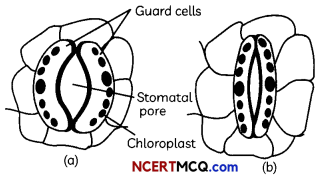
Raw Materials for Photosynthesis
- Water used in photosynthesis is taken up from the soil by the roots in terrestrial plants.
- Carbon dioxide is obtained by plants through the stomata in leaves. In most broad-leaved plants, the stomata are present only in the lower surface of the leaf but in narrow-leaved plants, they are equally distributed on both sides of the Leaf. The aquatic plants use the carbon dioxide dissolved in water.
- Other materials like nitrogen, phosphorus, iron and magnesium are taken up from the soil.
![]()
Example 1.
What are the necessary conditions for autotrophic nutrition and what are its byproducts?
Answer:
The necessary conditions for autotrophic nutrition are:
- Presence of chlorophyll in the living cell.
- Presence of sunlight to carry out photosynthesis.
- Sufficient amount of atmospheric CO2 which is required for the making of carbohydrates during photosynthesis.
- The adequate water supply to different parts of plant.
- The byproducts of autotrophic nutrition are starch (Carbohydrate), water and oxygen.
Heterotrophic Nutrition
Heterotrophic nutrition is defined as a type of nutrition in which energy is derived from the intake and digestion of the organic substances of plant or animal source. Ex-animals, bacteria and fungi.
Types of Heterotrophic Mode of Nutrition
The heterotrophic mode of nutrition is of three types:
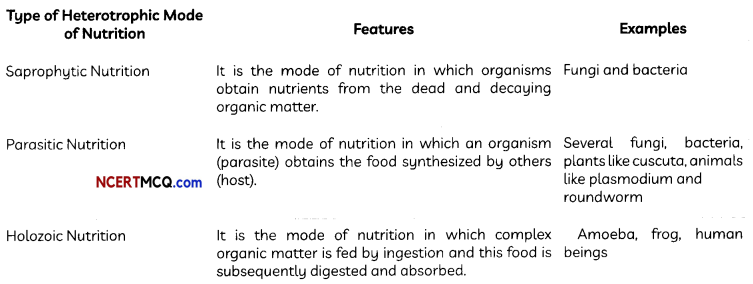
Example 2.
What are the differences between autotrophic nutrition and heterotrophic nutrition?
Answer:
The differences between autotrophic nutrition and heterotrophic nutrition are given below:
| Autotrophic Nutrition | Heterotrophic Nutrition |
| 1. In this type of nutrition organisms can synthesize their own food. | 1. In this type of nutrition organisms cannot prepare their own food. |
| 2. Raw materials required to prepare food are simple materials from the environment such as carbon dioxide and water in presence of sunlight. | 2. Energy is derived from the intake and digestion of inorganic complex organic substances prepared by other organisms, maybe, plants or animals. |
| 3. Green plants and certain bacteria like blue-green nutrition. | 3. All animals, most bacteria and fungi have algae that have chlorophyll have autotrophic heterotrophic nutrition. |
| 4. Autotrophs are the producers in the food chain. | 4. Heterotrophs are the consumers in the food chain. |
| 5. They store the food in the form of starch. | 5. They store the food in the form of glycogen. |
Nutrition in Amoeba
- The mode of nutrition of amoeba ¡s holozoic.
- It feeds on microscopic animals and plants.
- Phagocytosis: It is the process of obtaining food.
- Amoeba engulfs the food by forming pseudopodia. When the food is completely encircled and the tips of encircLing pseudopodia touch each other, the membrane at that point dissolves and the food is encaptured into the cell Like o bag called food vacuole.
- Food gets digested inside the food vacuole by digestive enzymes.
- Assimilation: The digested food diffuses into the cytoplasm and is utiLized by the cell
- Egestion: The undigested food remains in the food vacuole and is thrown out of the body.
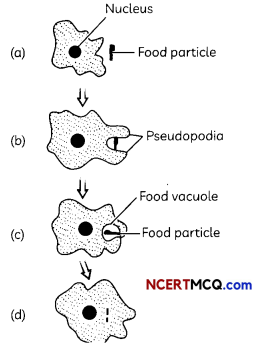
Nutrition in Paramecium:
In Paramecium, which is also a unicellular organism, the cell has a definite shape and food is taken in at a specific spot. Food is moved to this spot by the movement of cilia which cover the entire surface of the cell.
![]()
Example 3.
Case-Based:
Take 1 mL starch solution (1%) in two test tubes (A and B). Add 1 mL saliva to test tube A and leave both test tubes undisturbed for 20-30 minutes. Now add a few drops of dilute iodine solution to the test tubes.
(A) Select the correct observation on adding few drops of iodine solution to both the test tubes A and B:
| Test Tube A | Test Tube B |
| (a) Colour changes to blue-black | (a) Colour changes to blue-black |
| (b) No change in colour | (b) Colour changes to blue-black |
| (c) No change in colour | (c) No change in colour |
| (d) Colour changes to blue-black | (d) No change in colour |
Answer:
(b) Test Tube A: No change in colour; Test
Tube B: Colour changes to blue-black;
Explanation: We will observe a colour change in test tube B, showing presence of starch. Where as test tube A will show no colour change as due to addition of saliva, starch is converted into sugar by the enzyme salivary amylase.
(B) Select the incorrect statements from the statements given below:
(I) Starch is present in both the test tubes A and B even 30 minutes after adding saliva to test tube A.
(II) Only test tube B shows colour change on adding iodine solution.
(III) Starch is present only in test tube B
(IV) Starch is present only in test tube A
(a) Both (I) and (II)
(b) Both (II) and (III)
(c) Both (I) and (IV)
(d) Both (III) and (IV)
Answer:
(c) Both (I) and (IV)
Explanation: Starch is present only in test tube B as the salivary amylase enzyme present in saliva breaks down starch into sugar in about 30 minutes. Whereas, starch is still present in test tube B as it is not broken down into simpler substances.
(C) What conclusion can be made from this activity regarding the action of saliva on starch?
Answer:
It can be concluded that on addition of saliva in starch solution, the starch gets converted into some other product (here maltose sugar).
(D) Where does carbohydrate digestion begin in human beings?
Answer:
In human beings, carbohydrate digestion begins in the mouth as the salivary glands secrete the enzyme salivary amylase which breaks down the complex starch into sugar.
(E) Assertion (A): The starch solution to which saliva has been added does not turn iodine solution blue black after about 30 minutes.
Reason (R): Saliva contains salivary amylase which breaks down starch to sugar.
(a) Both (A) and (R) are true and (R) is the correct explanation of the assertion.
(b) Both (A) and (R) are true, but (R) is not the correct explanation of the assertion.
(c) (A) is true, but (R) is false.
(d) (A) is false, but (R) is true.
Answer:
(a) Both (A) and (R) are true and (R) is the correct explanation of the (A).
Explanation: We will observe a colour change in test tube B only, showing presence of starch. Where as test tube A will show no colour change as due to addition of saliva, starch is converted into sugar by the enzyme salivary amylase.
Nutrition in Human Beings
The human digestive system consists of the alimentary canal and its associated glands.
The organs which are responsible for ingestion, digestion, absorption, assimilation and egestion constitute the digestive system.
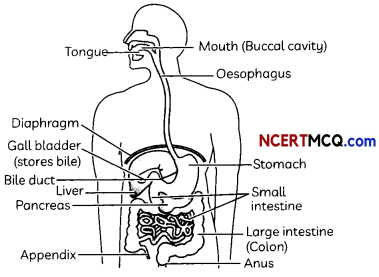
Human alimentary canal
Peristaltic Movements
The rhythmic contraction of the muscles lining the alimentary canal in order to push the food forward in a regulated manner along the digestive tube so that it can be processed properly in each part is known as peristaltic movements and these occur all along the gut.
Digestion in Mouth
When we eat any food, the first step is crushing of this food by our teeth and also mixing it with saliva. The saliva contains an enzyme called salivary amylase that breaks down starch which is a complex molecule to give sugar. The food is also wetted to make its passage through the alimentary canal smooth.
![]()
Digestion in Stomach
It lies below the diaphragm on the left side of the abdominal cavity and is J-shaped. The food is stored and partly digested in the stomach.
The gastric glands present in the wall of the stomach release hydrochloric acid, a protein-digesting enzyme called pepsin, and mucus.
Hydrochloric acid creates an acidic medium that facilitates the action of the enzyme pepsin. The acid also kills the harmful bacteria present in the stomach.
The mucus protects the inner lining of the stomach from the action of the acid under normal conditions. The exit of food from the stomach is regulated by a sphincter muscle which releases it in small amounts into the small intestine.
Digestion in Small Intestine
The small intestine is the site of the complete digestion of carbohydrates, proteins and fats. It receives the secretions of the liver and pancreas for this purpose.
Role of the liver:
- The bile juice from liver makes the food alkaline for the pancreatic enzymes to act as the food coming from the stomach is acidic.
- Bile salts break the large fat globules into smaller globules increasing the efficiency of enzyme action.
Role of pancreas: The pancreas secretes pancreatic juice which contains enzymes like trypsin for digesting proteins and lipase for breaking down emulsified fats.
The walls of the small intestine contain glands that secrete intestinal juice. The enzymes present in it finally convert the proteins to amino acids, complex carbohydrates into glucose and fats into fatty acids and glycerol.
End Products of Digestion
The end products of digestion of food are amino acids, glucose and fatty acids and glycerol.
Reason for shorter small intestines in carnivores:
The length of the small intestine differs in various animals depending on the food they eat. Herbivores eating grass need a longer small intestine to allow the cellulose to be digested. Meat is easier to digest, hence carnivores like tigers have a shorter small intestine.
Absorption of Food
These are finger-like projections present in the inner lining of the small intestines which increase the surface area for absorption. The villi are richly supplied with blood vessels that take the absorbed food to each and every cell of the body, where it is utilised for obtaining energy, building up new tissues and the repair of old tissues.
Assimilation
It is the process of utilization of food for building up or replacement purposes and for obtaining energy.
Egestion of Food
The unabsorbed food is sent into the Large intestine where more villi absorb water from this material. The rest of the material is removed from the body via the anus. The exit of this waste material is regulated by the anal sphincter.
![]()
Glands Associated with Digestive System
| Glands | Description |
| Salivary Glands | There are three pairs of salivary glands that secrete an enzyme called ptyalin or salivary amylase which digests starch. |
| Liver | It secretes bile which contains bile pigments and bile salts. The bile secreted by the liver cells is normally stored in the gall bladder. |
| Pancreas | It lies parallel to and beneath the stomach. It is a large gland that secretes digestive enzymes and hormones insulin and glucagons. |
Example 4.
How are fats digested in our bodies? Where does this process take place?
Answer:
The digestion of fats takes place in the small intestine. The first step is the emulsification of fats. Fats are present in the intestine in the form of large globules. The fat-digesting enzymes are not able to act upon large globules efficiently. Small intestine receives the secretions of the liver and pancreas for this purpose.
Bile salts present in the bile juice from the liver emulsify the large globules of fats and break them down into smaller globules. The pancreas secretes pancreatic juice which contains lipase enzymes for breaking down emulsified fats. The walls of the small intestine contain glands that secrete intestinal juice. The enzymes present in it finally convert the fats into fatty acids and glycerol.